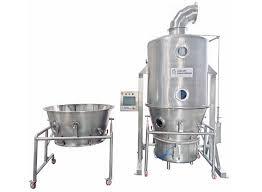A fluid bed dryer is an essential piece of equipment used in various industries for drying granular, powdery, and crystalline materials. It operates by passing hot air through a bed of material, causing it to behave like a fluid, which ensures even and efficient drying. Due to its effectiveness and versatility, fluid bed drying technology is widely used in industries such as pharmaceuticals, food processing, chemicals, and agriculture. However, different types of fluid bed dryers are available to cater to specific drying requirements. This article explores the various types of fluid bed dryers, their working principles, advantages, and applications.
1. Batch Fluid Bed Dryer
A batch fluid bed dryer is designed for drying materials in batches, where a fixed quantity of material is processed at a time. The drying process takes place in a controlled environment, ensuring uniform drying of the material before a new batch is introduced.
Working Principle:
- Material is placed into the drying chamber.
- Hot air is introduced from the bottom, fluidizing the material.
- Moisture is evaporated, and dried material is collected after completion.
- The cycle repeats for each new batch.
Advantages:
- Ideal for small-scale production.
- Offers precise control over drying conditions.
- Suitable for heat-sensitive materials.
Applications:
- Pharmaceutical industry for drying granules and powders.
- Food industry for drying herbs and spices.
- Chemical industry for processing specialty chemicals.
2. Continuous Fluid Bed Dryer
A continuous fluid bed dryer operates non-stop, making it ideal for large-scale industrial applications where high production rates are required.
Working Principle:
- Material continuously enters the drying chamber from one end.
- Hot air flows through the material, fluidizing it and removing moisture.
- The dried product exits from the other end of the dryer.
Advantages:
- Suitable for high-volume production.
- Energy-efficient due to continuous operation.
- Ensures consistent product quality.
Applications:
- Food processing for drying grains and cereals.
- Chemical industry for drying bulk chemicals.
- Pharmaceutical manufacturing for drying excipients and active ingredients.
3. Vibrating Fluid Bed Dryer
A vibrating fluid bed dryer incorporates vibration technology to improve fluidization and enhance drying efficiency.
Working Principle:
- Material enters the drying chamber, where hot air is introduced from below.
- A vibrating mechanism agitates the material, promoting better fluidization.
- Moisture is evaporated, and the dried product is discharged continuously.
Advantages:
- Improves drying efficiency for sticky or irregularly shaped particles.
- Reduces air pressure requirements, saving energy.
- Prevents material clumping and ensures uniform drying.
Applications:
- Food industry for drying sugar and salt.
- Chemical industry for drying resin and catalysts.
- Pharmaceutical industry for drying active pharmaceutical ingredients (APIs).
4. Fluidized Bed Granulator Dryer
This type of fluid bed dryer is a combination of drying and granulation, making it ideal for industries that require both functions in one system.
Working Principle:
- Powdered material is introduced into the fluid bed chamber.
- A binding solution is sprayed to form granules while hot air dries them simultaneously.
- The process results in uniform granules with controlled particle size.
Advantages:
- Saves time and cost by combining granulation and drying.
- Produces uniform granules with excellent flow properties.
- Reduces processing steps, increasing efficiency.
Applications:
- Pharmaceutical industry for tablet formulation.
- Food industry for granulated food products.
- Chemical industry for specialty granules.
5. Spouted Bed Dryer
A spouted bed dryer is a variation of the fluid bed dryer that is designed for handling larger or irregularly shaped particles.
Working Principle:
- Hot air is introduced through a narrow opening, creating a spouting effect.
- Particles are lifted in a cyclic motion, ensuring effective drying.
- Moisture is evaporated as the material circulates.
Advantages:
- Suitable for larger and coarser materials.
- Prevents material sticking and ensures even drying.
- Provides better heat and mass transfer compared to conventional fluid bed dryers.
Applications:
- Food industry for drying coffee beans and peas.
- Chemical industry for drying granules with irregular shapes.
- Agricultural industry for processing seeds and grains.
6. Superheated Steam Fluid Bed Dryer
This advanced type of fluid bed dryer uses superheated steam instead of hot air for drying, making it ideal for heat-sensitive materials.
Working Principle:
- Superheated steam is introduced to fluidize the material.
- The absence of oxygen prevents oxidation and enhances heat transfer.
- Moisture is removed while maintaining material integrity.
Advantages:
- Reduces risk of oxidation for sensitive materials.
- Ensures uniform drying with high energy efficiency.
- Can be used for sterilization alongside drying.
Applications:
- Pharmaceutical industry for drying hygroscopic materials.
- Food industry for drying heat-sensitive products.
- Chemical industry for drying materials prone to oxidation.
Choosing the Right Fluid Bed Dryer
Selecting the appropriate fluid bed dryer depends on various factors, including:
- Material Characteristics: Particle size, shape, and moisture content.
- Production Scale: Batch versus continuous processing needs.
- Energy Efficiency: Energy consumption requirements.
- Application Requirements: Industry-specific needs and regulatory compliance.
Conclusion
Fluid bed dryers come in various types, each designed to meet specific industrial drying needs. From batch and continuous systems to advanced vibrating and superheated steam dryers, the right choice depends on the material, process requirements, and efficiency goals. Understanding these different types of fluid bed dryers helps industries optimize their drying processes, reduce costs, and improve product quality. Whether in pharmaceuticals, food processing, or chemical production, fluid bed drying technology continues to be a cornerstone for efficient material processing.

